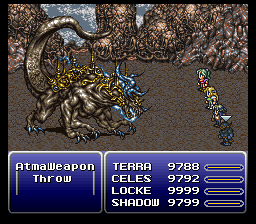

Its story took players across a vast overworld before it plunged down to an underground land, and then shot for the moon. It was one of the biggest and most ambitious RPGs to exist on the SNES at the time. Final Fantasy 4 had just been released in the U.S. Woolsey joined Squaresoft's American office at Redmond, Washington in 1991. For the entirety of the 16-bit RPG renaissance and beyond, the liberties Woolsey took with Final Fantasy 6's translation was a hot battleground on Usenet, message boards, and IRC chat rooms. The war between people who prefer colorful, highly localized interpretations of Japanese content and the people who prefer straight translations is as old as internet fandom. There are slings and arrows too, however. That's why the man behind the translations, Ted Woolsey, is still celebrated for his work. It's remarkable to realize Square Enix's ability to deliver such a powerful story about death, devastation, and the end of the world while under the watchful eye of Nintendo of America's content censors. Final Fantasy 6's story inspired more than one budding writer to pick up their pen and go wild. Professional authors even cite Final Fantasy 6 as a major inspiration for their works.

In particular, the localization for Final Fantasy 6 is so ingrained in fans' minds that certain character quirks and bits of dialogue have carried over into modern Final Fantasy games. They built up the worlds they belonged to, gave life and character to hero and monster alike. Squaresoft's RPGs weren't just clear and competent. In time, these newly-baptized RPG fans and the veterans who fell in love with the genre through Dragon Warrior came to the same observation: Many of the RPGs produced by Square Enix (then Squaresoft) boasted next-level translations in an era where video game localizations were still infamous for being shoddy. Though RPGs wouldn't reach anything close to mainstream popularity until Final Fantasy 7 hit the PlayStation in 1997, the candy-colored sprites in Secret of Mana and the solemn, realistic backdrops of Final Fantasy 6-released in the West as Final Fantasy 3- turned some heads and won some hearts. The 16-bit era was a renaissance for console RPGs, especially for Westerners. It's fine to journey for 60 hours with wooden heroes it's better to come come away from the adventure bright-eyed and stuffed full of one-liners like, "Don't tease the octopus, kids!" and, "You sound like a chapter from a self-help booklet." We don't say it often enough, but the people who translated those games and added flavor to their characters, stories, and worlds deserve some credit for these discoveries. Every RPG enthusiast can recall what game they were playing when they were struck by the fandom's universal epiphany: The realization that RPGs can treat us to rich stories and deep character rosters that rival classic fantasy novels.


 0 kommentar(er)
0 kommentar(er)
